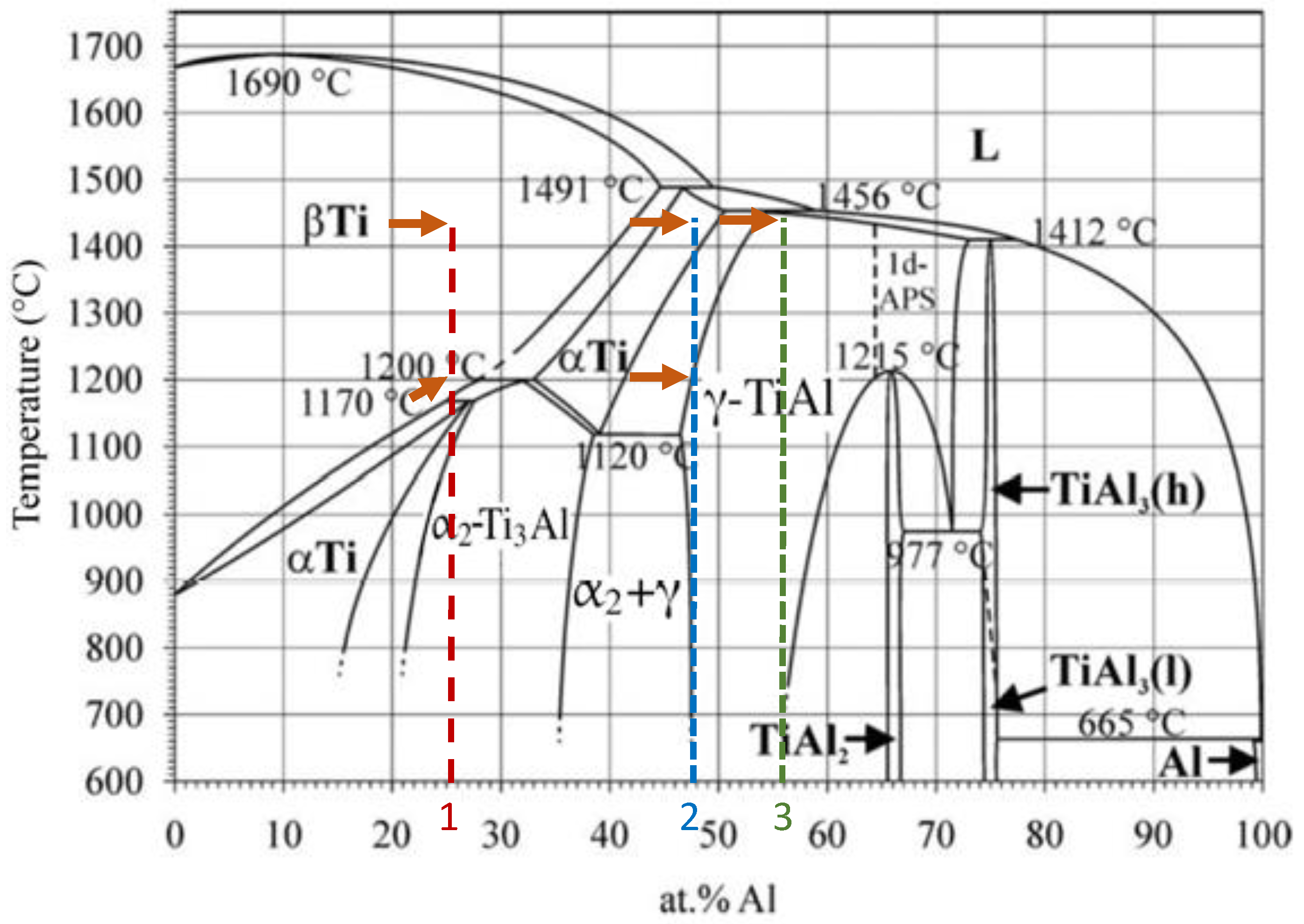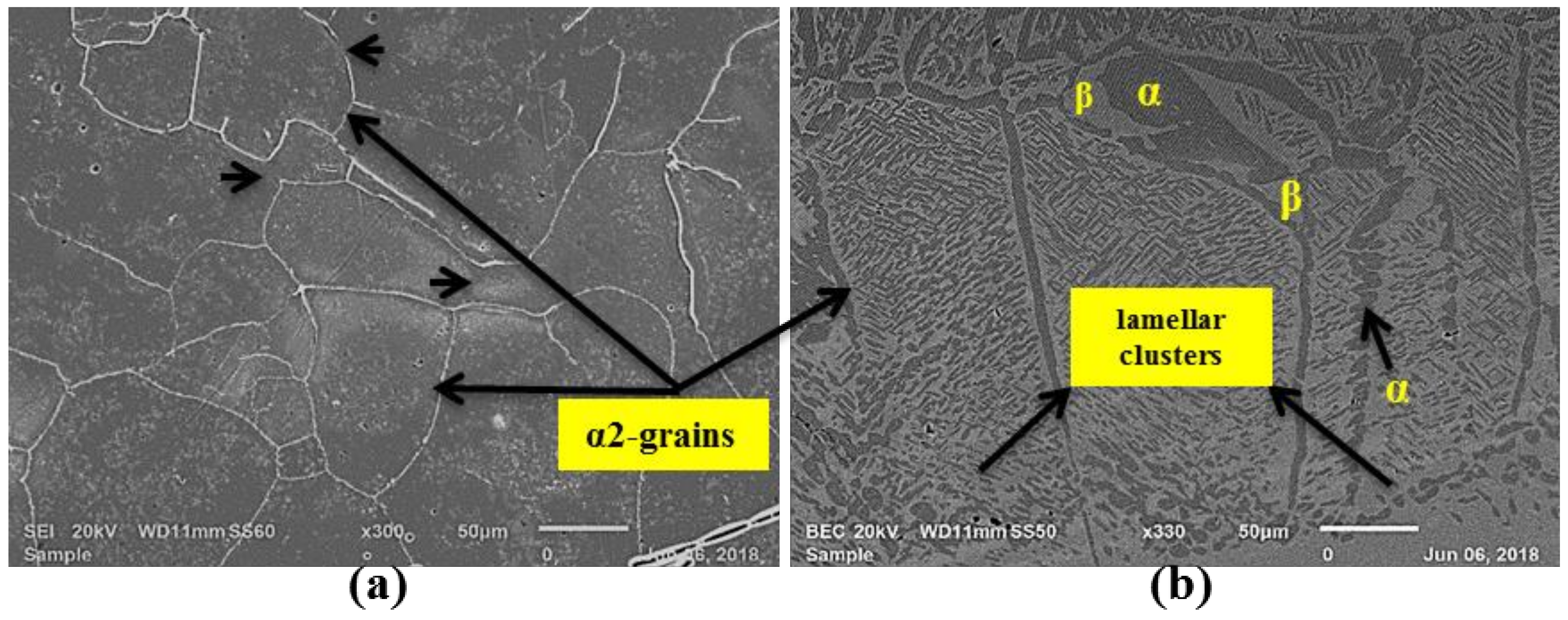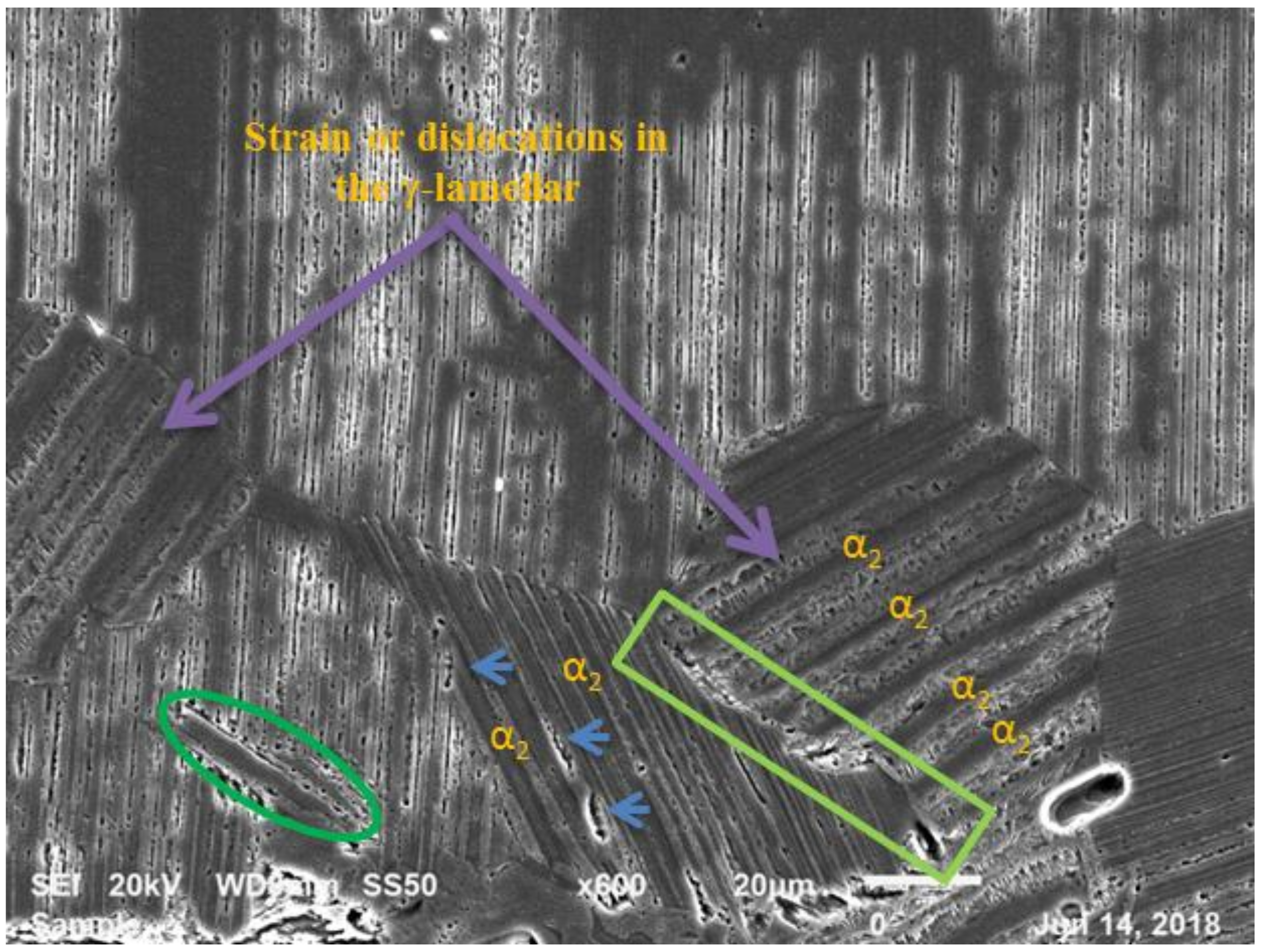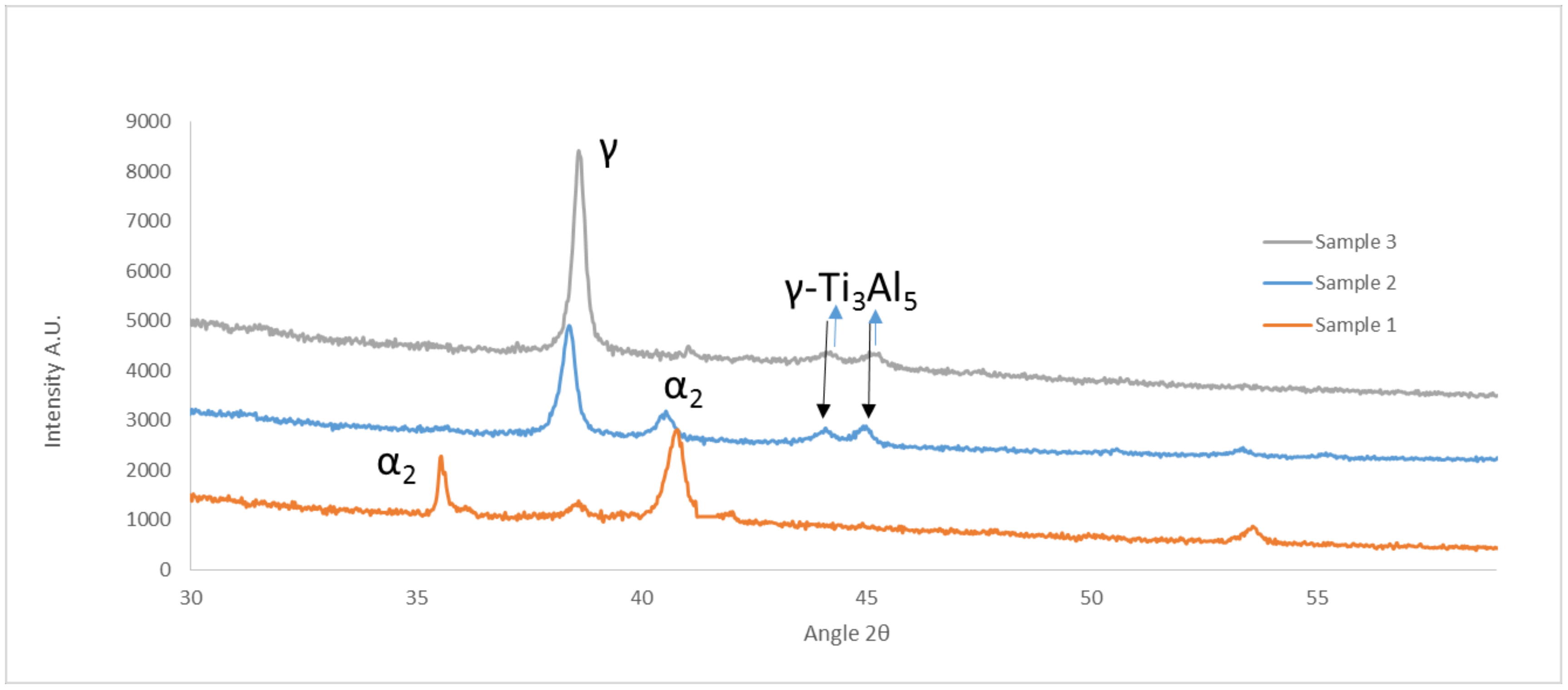Heat Treatment of In Situ Laser-Fabricated Titanium Aluminide
Abstract
:1. Introduction
2. Materials and Methodology
3. Results and Discussion
3.1. Composition and Microstructure
3.1.1. Composition
3.1.2. Cross Sections and Microstructure Prior to Heat Treatment
3.1.3. Microstructure after Heat Treatment
3.2. X-ray Diffraction
3.3. Microhardness
4. Conclusions
Author Contributions
Funding
Acknowledgments
Conflicts of Interest
References
- Kothari, K.; Radhakrishnan, R.; Wereley, N.M. Advances in gamma titanium aluminides and their manufacturing techniques. Prog. Aerosp. Sci. 2012, 55, 1–16. [Google Scholar] [CrossRef]
- Chraponski, J.; Szkliniarz, W.; Koscielna, A.; Serek, B. Microstructure and chemical composition of phases in Ti–48Al–2Cr–2Nb intermetallic alloy. Mater. Chem. Phys. 2003, 81, 438–442. [Google Scholar] [CrossRef]
- Lasalmonie, A. Intermetallics: Why is it so difficult to introduce them in gas turbine engines? Intermetallics 2006, 14, 1123–1129. [Google Scholar] [CrossRef]
- Viswanathan, G.B.; Kartikeyan, S.; Mills, M.J.; Vasudevan, V.K. Creep properties of a fully-lamellar Ti–48Al–2Cr–2Nb alloy. Mater. Sci. Eng. A 2001, 319–321, 833–837. [Google Scholar] [CrossRef]
- Xia, Y.; Luo, S.D.; Wub, X.; Schaffer, G.B.; Qian, M. The sintering densification, microstructure and mechanical properties of gamma Ti–48Al–2Cr–2Nb alloy with a small addition of copper. Mater. Sci. Eng. A 2013, 559, 293–300. [Google Scholar] [CrossRef]
- Mercer, C.; Lou, J.; Soboyejo, W.O. An investigation of fatigue crack growth in a cast lamellar Ti_48Al_2Cr_2Nb alloy. Mater. Sci. Eng. A 2000, 284, 235–245. [Google Scholar] [CrossRef]
- Schwerdtfeger, J.; Körner, C. Selective electron beam melting of Ti-48Al-2Nb-2Cr: Microstructure and aluminium loss. Intermetallics 2014, 49, 29–35. [Google Scholar] [CrossRef]
- Sunderkiitter, J.D.; Schmutzler, H.J.; Haanappel, V.A.C.; Hofmant, R.; Glatz, W.; Clemen, H.; Stroosnijde, M.F. The high-temperature oxidation behaviour of Ti-47Al-2Cr-0.2Si and Ti-48Al-2Cr-2Nb compared with Ti-48Al-2Cr. Intermetallics 1997, 5, 525–534. [Google Scholar] [CrossRef]
- Kościelna, A.; Szkliniarz, W. Effect of cyclic heat treatment parameters on the grain refinement of Ti–48Al–2Cr–2Nb alloy. Mater. Charact. 2009, 60, 1158–1162. [Google Scholar] [CrossRef]
- Seifi, M.; Ghamarian, I.; Samimi, P.; Ackelid, U.; Collins, P.; Lewandowski, J. Microstructure and mechanical properties of Ti-48Al-2Cr-2Nb manufactured via electron beam melting. In Proceedings of the 13th World Conference on Titanium, San Diego, CA, USA, 16–20 August 2015; Vasisht Venkatesh, A.L., Pilchak, J.E., Allison, S.A., Rodney Boyer, J.C., Amish, L., Fraser, M., Ashraf Imam, Y.K., Henry, J., Rack, A.C., Andy, W., Eds.; Minerals, Metals & Materials Society: Pittsburgh, PA, USA, 2016; pp. 1317–1322. Available online: https://www.researchgate.net/profile/Iman_Ghamarian/publication/280024707_Microstructure_and_Mechanical_Properties_of_Ti-48Al-2Cr-2Nb_Manufactured_Via_Electron_Beam_Melting/links/59e17f7ea6fdcc7154d37618/Microstructure-and-Mechanical-Properties-of-Ti-48Al-2Cr-2Nb-Manufactured-Via-Electron-Beam-Melting.pdf (accessed on 7 August 2018).
- Murr, L.E.; Gaytan, S.M.; Ceylan, A.; Martinez, E.; Martinez, J.L.; Hernandez, D.H.; Machado, B.I.; Ramirez, D.A.; Medina, F.; Collins, S.; et al. Characterization of titanium aluminide alloy components fabricated by additive manufacturing using electron beam melting. Acta Mater. 2010, 58, 1887–1894. [Google Scholar] [CrossRef]
- Nochovnaya, N.A.; Panin, P.V.; Kochetkov, A.S.; Bokov, K.A. Modern Refractory alloys based on titanium gamma-aluminide. Prospect Dev. Appl. Metal Sci. Heat Treat. 2014, 56, 23–27. [Google Scholar]
- Mayer, S.; Erdely, P.; Fischer, F.D.; Holec, D.; Kastenhuber, M.; Klein, T.; Clemens, H. Intermetallic β-Solidifying γ-TiAl Based Alloys from Fundamental Research to Application. Adv. Eng. Mater. 2017, 19, 1–27. [Google Scholar] [CrossRef]
- Sina, H.; Iyengar, S. Reactive synthesis and characterization of titanium aluminides produced from elemental powder mixtures. J. Therm. Anal. Calorim. 2015, 122, 689–698. [Google Scholar] [CrossRef]
- Deve, H.E.; Evens, A.G.; Shih, D.S. A high toughness γ-titanium aluminide. Acta. Metall. Mater. 1992, 40, 1259–1265. [Google Scholar] [CrossRef]
- Tlotleng, M.; Masina, B.; Pityana, S. Characteristics of Laser in-Situ alloyed titanium aluminides coatings. Procedia Manuf. 2017, 7, 39–45. [Google Scholar] [CrossRef]
- Zambaldi, C.R. Micro-mechanical modelling of γ-TiAl alloys. Rwth Aachen. 2010. Available online: www.rwth-aachen.de/record/64344/files/3607.pdf (accessed on 7 August 2018).
- Kacher, J.; Eftink, B.P.; Cui, B.; Robertson, I.M. Dislocation interactions with grain boundaries. Curr. Opin. Sol. State Mater. Sci. 2014, 18, 227–243. [Google Scholar] [CrossRef]
- Appel, F.; Clemens, H.; Fischer, F.D.; Kim, Y.W.; Dimiduk, D. Progress in the understanding of gamma titanium aluminides. J. Mater. 1991, 43, 40–47. [Google Scholar]
- Choi, C.; Kim, H.J.; Lee, Y.T.; Kim, Y. Effects of microstructural parameters on the fatigue crack growth of fully lamellar gamma-TiAl alloys. Mater. Sci. Eng. A 2002, 329–331, 545–556. [Google Scholar] [CrossRef]
- Dimiduk, D.; Martin, P.; Kim, Y.W. Microstructure development in gamma TiAl alloy mill products by thermomechanical processing. Mater. Sci. Eng. A 1998, 243, 66–76. [Google Scholar] [CrossRef]
- Todai, M.; Nakano, T.; Tianqi, L.; Hiroyuki, Y.Y.; Koji, H.; Ken, C.; Minoru, U.; Masao, T. Effect of building direction on the microstructure and tensile properties of Ti-48Al-2Cr-2Nb alloy additively manufactured by electron beam melting. Addit. Manuf. 2017, 13, 61–70. [Google Scholar] [CrossRef]
- Fitzner, A.; Prakash, D.G.L.; da Fonseca, J.Q.; Thomas, M.; Zhang, S.; Kelleher, J.; Manuel, P.; Preuss, M. The effect of aluminium on twinning in binary alpha-titanium. Acta. Mater. 2016, 103, 341–351. [Google Scholar] [CrossRef]
- Azadmanjiri, J.; Berndt, C.; Kapoor, A.; Wen, C. Development of Surface Nano-Crystallization in Alloys by Mechanical Attrition Treatment (SMAT). Crit. Rev. Sol. State Mater. Sci. 2015, 3, 164–181. [Google Scholar] [CrossRef]
- Edwards, T.; Di Gioacchino, F.; Moreno, R.; Clegg, W.J. The interaction of borides and longitudinal twinning in polycrystalline TiAl alloys. Acta Mater. 2017, 140, 305–316. [Google Scholar] [CrossRef]
- Baudana, G.; Biamino, S.; Ugues, D.; Lombardi, M.; Fino, P.; Pavese, M.; Badini, C. Titanium aluminides for aerospace and automotive applications processed by Electron Beam Melting: Contribution of Politecnico di Torino. Met. Powder Rep. 2016, 71, 193–199. [Google Scholar] [CrossRef]
- Tambburini, U.; Ohyanga, M.; Munir, Z. Modelling studies of the effect of twins on the X-ray diffraction patterns of boron carbide. Chem. Mater. 2004, 16, 4347–4351. [Google Scholar] [CrossRef]
- Wang, G.; Dahms, M. Synthesizing gamma-TiAl alloys by reactive powder processing. JOM 1993, 45, 52–56. [Google Scholar] [CrossRef]
- Fukotomi, M.; Hasegawa, H. Lamellar orientation control in TiAl base alloys by a Two-step compression process at high temperature. Mater. Sci. Eng. A 2009, 508, 106–113. [Google Scholar]







| Sample ID | Aluminium Composition (at. %) |
|---|---|
| 1 | 25.62 ± 1.2 |
| 2 | 47.47 ± 0.8 |
| 3 | 55.84 ± 1.5 |
| Sample | Al Content (at. %) | Heat-Treatment Temperature | Microstructure | Hardness (HV 0.5) |
|---|---|---|---|---|
| 1 | 25.6 | 1200 °C | Hexagonal | 522.4 ± 55.1 |
| 1 | 25.6 | 1430 °C | Partial Lamellar | 502.8 ± 44.2 |
| 2 | 47.5 | 1200 °C | Duplex | 324.8 ± 21.5 |
| 2 | 47.5 | 1430 °C | Fully Lamellar | 344 ± 23.8 |
| 3 | 55.8 | 1430 °C | Fully lamellar | 593.6 ± 17.5 |
© 2018 by the authors. Licensee MDPI, Basel, Switzerland. This article is an open access article distributed under the terms and conditions of the Creative Commons Attribution (CC BY) license (http://creativecommons.org/licenses/by/4.0/).
Share and Cite
Hoosain, S.E.; Pityana, S.; Freemantle, C.S.; Tlotleng, M. Heat Treatment of In Situ Laser-Fabricated Titanium Aluminide. Metals 2018, 8, 655. https://doi.org/10.3390/met8090655
Hoosain SE, Pityana S, Freemantle CS, Tlotleng M. Heat Treatment of In Situ Laser-Fabricated Titanium Aluminide. Metals. 2018; 8(9):655. https://doi.org/10.3390/met8090655
Chicago/Turabian StyleHoosain, Shaik E., Sisa Pityana, Christopher S. Freemantle, and Monnamme Tlotleng. 2018. "Heat Treatment of In Situ Laser-Fabricated Titanium Aluminide" Metals 8, no. 9: 655. https://doi.org/10.3390/met8090655





